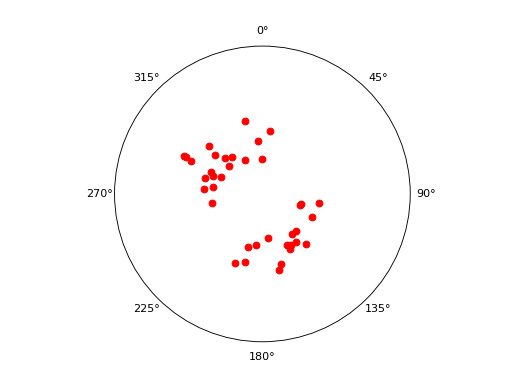parse_angelier_data.py¶
This is meant to serve as an example of slightly more complex parsing of orientation measurements.
Angelier, 1979’s seminal paper on paleostress determination includes a table of slickenslide measurements from normal faults.
However, some of the measurements are rakes, while others are strike/dip and an azimuth of the slickenslides (“Rake” measurements without a direction letter are actually azimuthal measurements.).
Furthermore, the measurements do not follow the right-hand-rule for indicating dip direction of a plane and they indicate rake direction using a directional letter.
To unify the measurements for plotting, etc, we need to parse all of the measurements, and convert the azimuth measurements to rakes.
import os
import matplotlib.pyplot as plt
import mplstereonet
def main():
strike, dip, rake = load()
# Plot the data.
fig = plt.figure()
ax = fig.add_subplot(111, projection='stereonet')
ax.rake(strike, dip, rake, 'ro')
plt.show()
def load():
"""Read data from a text file on disk."""
# Get the data file relative to this file's location...
datadir = os.path.dirname(__file__)
filename = os.path.join(datadir, 'angelier_data.txt')
data = []
with open(filename, 'r') as infile:
for line in infile:
# Skip comments
if line.startswith('#'):
continue
# First column: strike, second: dip, third: rake.
strike, dip, rake = line.strip().split()
if rake[-1].isalpha():
# If there's a directional letter on the rake column, parse it
# normally.
strike, dip, rake = mplstereonet.parse_rake(strike, dip, rake)
else:
# Otherwise, it's actually an azimuthal measurement of the
# slickenslide directions, so we need to convert it to a rake.
strike, dip = mplstereonet.parse_strike_dip(strike, dip)
azimuth = float(rake)
rake = mplstereonet.azimuth2rake(strike, dip, azimuth)
data.append([strike, dip, rake])
# Separate the columns back out
strike, dip, rake = zip(*data)
return strike, dip, rake
if __name__ == '__main__':
main()
Result¶
